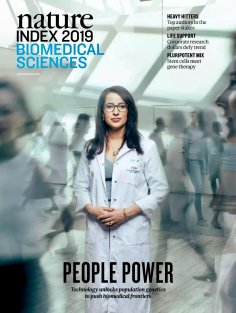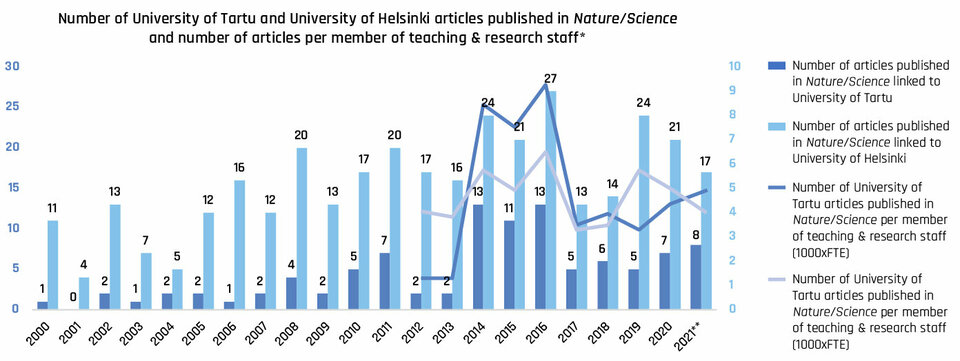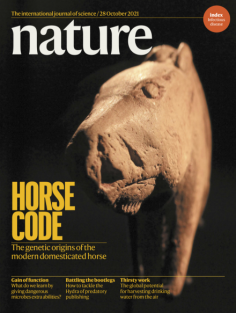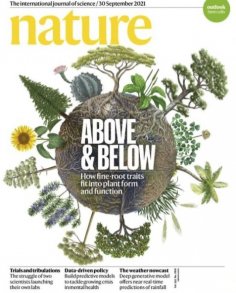University of Tartu researchers are contributing more than ever to world science
International awareness of influential research by scientists from the University of Tartu has increased significantly over the last 100 years, as reflected in the number of studies whose results have been published in the pre-eminent magazines Nature and Science.
The weekly English-language academic journals Nature (first published in the United Kingdom in 1869) and Science (first published in the United States in 1880) were founded on the principle that the scientific achievements they showcased should be comprehensible to all readers and focus on key issues in global science.
They were not the first magazines of their kind, but many years of consistent work saw them become the most widely read and most frequently cited scientific journals in the world during the 20th century. Since the aim of both magazines is to promote scientific innovations, the research articles they publish are never very long, which is why the journals are also popular outside of scientific circles.
An article being published in Nature or Science is a mark of great recognition for its author: the impact it has on their reputation, career and funding can be enormous.
The first article published in Nature that is thought to be linked to the University of Tartu is one from 1925 entitled ‘Demonstration of the Heating Effect of a Magnetic Field’1, whose author was University of Tartu professor of theoretical and technical physics Harald Perlitz. A series of further articles penned by Perlitz2 would go on to be published by the magazine.
The first article linked to the University of Tartu to be published in Science is more difficult to pinpoint, although a number of news features from the 1920s and 1930s make mention of events taking place and researchers working at the University of Tartu. For example, in 1931 it was announced in the magazine that Professor Ernst Öpik would be joining the astronomical research group at Harvard3.
References to local scientists and to research taking place in Tartu generally and the University of Tartu specifically can also be found in much earlier issues of both magazines: an 1881 issue of Science4 mentions additions to Friedrich Georg Wilhelm von Struve’s catalogue of binary stars (1827), while an 1876 issue of Nature5 pays its respects to the recently departed Karl Ernst von Baer.
Overcoming obstacles to access Western science
For scientists in the Soviet Union, publishing their work in these Western academic journals was not a primary objective, since dong so often entailed a lot more effort. Nevertheless, articles by researchers from Tartu State University (as it was known at the time) did appear in the magazines, including one by now Professor Emeritus of the Institute of Physics and academic Arvi Freiberg (in Nature in 19886) and a book review co-authored by former rector and academic Peeter Tulviste (in Science in 19907).

Freiberg recalls that his article, on the influence of molecular disorder on photosynthesis, was completed in cooperation with Moscow State University biophysicist Zoya Fetisova and was the third or fourth work the pair had co-authored. Fetisova prepared the test objects and brought them to Tartu, where all of the necessary measurements were undertaken. Freiberg says that the idea of submitting the article to Nature undoubtedly came from Fetisova.
“I don’t remember us discussing it at any great length, since no one, including Zoya, really believed they’d go for it,” he admits. “Since this was the Soviet era, the article was submitted from Moscow, but I don’t recall there being any particular machinations surrounding it in that regard. To the surprise of us all, they said yes straight away!”
Needless to say the scientists were highly gratified that their article had been accepted for publication, since it confirmed both the topicality and quality of their research – and constituted international recognition of their work, which had met with little more than a lukewarm reception among colleagues in their own institute and academy.
Freiberg says that the attitude towards being published was rather different three decades ago than it is today. However, when the field of research opened up overnight and became much trickier to navigate, an innate need for ‘beacons’ arose.
“I’m one of those people who thinks that getting articles published is – or at least should be – secondary to the research itself,” Freiberg explains. “Beacons are wonderful things, but if there are too few of them, ships still tend to run aground. A mere handful of them can’t warn against all possible danger. And when there aren’t that many of them, they tend to attract too many vessels at once, all of which vie – some more aggressively than others – for the best positions.”
One of the most respected Estonian scientists to appear in the pages of Nature is Jaan Einasto, whose articles have been published in the magazine since 19748. He once wrote briefly on this topic in the journal Akadeemia:9 “Getting articles published in Nature was difficult, since the postal system moved at a glacial pace and everything was subject to censorship under the beady eye of Glavlit [the General Directorate for the Protection of State Secrets of the Soviet Union].”
Einasto recalls that the articles in question were milestones in the development of a new cosmological paradigm. “Before then, scientists from the West had little if any knowledge about us astronomers in Tartu, then suddenly our names were everywhere,” he says. “It was even the same in the Soviet Union, really – the Moscow boys never paid much heed to the research being done on the peripheries. Then all of a sudden Tartu was doing big things at the international level. Local acknowledgement was still a while in coming, but I was eventually elected a member of the Estonian Academy of Sciences in 1981.”
Recognition and funding
In the decade after Estonia regained its independence, articles linked to the University of Tartu were published in Nature and Science at the rate of one or two a year. Since then, their number has grown markedly: by the mid-2010s, more than 10 articles by researchers from the university were being published every year. In fact, in the period from 2014-2017, the UNIVERSITY OF TARTU saw more articles published per member of teaching and research staff than e.g. the University of Helsinki in neighbouring Finland.

* Publication data derive from the Web of Science database as at 11 November 2021. University of Tartu employee data derive from the university’s statistics site. University of Helsinki employee data derive from the university’s annual reports. Population data derive from the World Bank database.
** Data for 2021 have yet to be confirmed. Comparative data pertaining to employees and population are from 2020.
Moreover, the University of Tartu is the undisputed leader in Estonia in terms of the number of articles appearing in Nature and Science, accounting for around 70% of all Estonian articles published in the magazines. The number of publications by universities of different sizes can be compared according to the number of teaching and research staff working at them, but such indicators are difficult to obtain and calculate on a country-by-country basis.
One way is to count the number of Nature and Science articles per 1,000,000 inhabitants. In that regard, Estonia is very well placed compared to its Northern European neighbours: in some years, local scientists have had more articles published in the magazines than their colleagues from Finland, for example. In recent years, the pace of growth has very much levelled out.
These articles include publications by researchers from all of the faculties and institutions at the University of Tartu, but dominant among them are geneticists and ecologists. Professor Mari Moora from the Institute of Ecology and Earth Sciences acknowledges that having an article published in Nature or Science is a major achievement for an ecologist.
“These are journals that cover anything and everything, so you’re battling for space in them with every other branch of science,” she explains. “They’re also the most influential magazines in which ecological works are published. Not even the most prestigious journals that focus on ecology alone wield as much influence – which stems, of course, from the fact that in global terms, ecology is a smaller branch of science than, say, biomedicine or molecular biology.”
The impact that such publications have can clearly be seen within the international scientific community: authoring an article in Nature or Science can significantly increase chances of success in applying for grants. Professor Heikki Junninen from the Institute of Physics confirms that financiers keep a close eye on citation-based indicators boosted by publication in respected scientific journals.
The impact an article published in Nature or Science can have is hard to put into numbers, but I have heard it claimed that a single article can indirectly bring the author’s university around a million euros
“The impact an article published in Nature or Science can have is hard to put into numbers, but I have heard it claimed that a single article can indirectly bring the author’s university around a million euros,” he reveals. “And the number of articles published not only reflects a working group’s ability to do research at a high level, but also a university’s ability to recognise and support activities that are truly significant and world-leading from the point of view of global science.”
In the case of these and other influential scientific magazines, Junninen says the most important thing for researchers is nevertheless the extent to which their work is cited. This means distributing the work and the ideas it contains as widely as possible and getting other researchers involved. For the University of Tartu, doing so leads to greater recognition and more opportunities for cooperation, and increases the likelihood that highly capable scientists and students will be drawn to Tartu from all over Europe.
Given which Estonian scientists (including those from the University of Tartu) have had articles published in Nature and Science in the last 20 years and when they were published, it can be hypothesised that these prestigious publications and the funding of activities at leading centres of Estonian research are strongly linked.
Although the vast majority of publications bear no reference to such funding or to the EU Structural Funds, a number of employees, academic and non-academic alike, are convinced that the link exists. At the same time, scientists from the University of Tartu have proven more successful with each passing year in the European Union framework programme and have been taking part in an ever-increasing number of cooperation projects.
The programme operates to a seven-year funding cycle similar to that of centres financed via the Structural Funds. As such, the number of publications may also be linked to overall growth in international scientific cooperation. Either way, whether we look at the issue in the narrower context of the Structural Funds or more broadly in terms of developments in scientific work internationally, Estonian research – including that undertaken at the University of Tartu – is at a very high level.
World-leading science comes of international cooperation
There is no ignoring the fact that researchers from the University of Tartu have not led the process or been the authors responsible for the majority of the significant and successful publications mentioned above. This is a regional phenomenon: 83-85% of the articles published in Nature and Science by universities in Western Europe are the result of international cooperation, whereas the same figure for universities in Eastern Europe is 91-95%. Such cooperation plays a crucial role in the publication of these works.

The October 2021 issue of Nature featured an article on the domestic horses found on the steppes in the western part of Eurasia. This article had a grand total of 163 co-authors – one of whom was Eve Rannamäe, an associate professor at the Institute of History and Archaeology of the University of Tartu who provided the study with archaeological samples of horse bone from Estonia and background information thereon.
“Even given the size of the team, the whole process was very friendly and professional,” she says. “To me, the excitement and the pride with which everyone awaited the showcasing of the results of the study, which proved complex and expensive and took a very long time to complete, shows just what a magazine Nature is. To be so close to that, to world-class science, is an invaluable experience and gives you plenty of inspiration going forward with your own research.”
Although Nature and Science are two of the world’s most prestigious magazines, they are no longer the most globally influential scientific journals. In order to extend their reach to specific areas of research, they have launched a large number of sister publications in recent decades: five for Science and as many as 51 for Nature, some of which are now more influential than the magazines that spawned them.
Although they come up against little if any competition in the multidisciplinary science category, the annual Journal Citation Report on the influence wielded by scientific magazines (compiled on the basis of citation data from the Web of Science database) only ranks Nature 22nd and Science 24th. Seven of Nature’s sister publications are among the top 10 most influential scientific journals,
while the 100 most cited include 44 magazines in the larger Nature and Science family. Since 2000 (up to November 2021) a total of 222 articles involving the contribution of researchers from the UNIVERSITY OF TARTU have been published in these magazines, the author responsible for 31 of which was a UNIVERSITY OF TARTU researcher. There are some fields of science in which the sister publications are cited just as much or even more so than the two main magazines combined.
This follows the same logic as per Nature and Science: the number of articles linked to the University of Tartu began to rise in the mid-2000s before peaking in the mid-2010s.
World-leading science driven by society’s interests
The forthcoming UNIVERSITY OF TARTU institutional accreditation report states that recent years have been marked by advancements in the quality and results of research and development work, including in the number of scientists at the forefront of their fields. According to Essential Science Indicators (the Web of Science module which analyses the most widely cited publications), whereas the UNIVERSITY OF TARTU was among the most cited research institutes in just six fields of science in 2011, then by 2016 it was among the most cited in nine fields and by 2021 in 14 fields, out of a total of 22.

Its overall number of scientific publications has remained relatively stable, as has its number of articles published per member of academic staff, but among them there has been a rise in the number of high-level articles, meeting the university’s objective of prioritising quality over quantity.
A doctoral student in the field of medicine at the university remarked during lectures covering the publication of scientific work that they started at the top when looking for a magazine in which to publish their first article: the world’s leading medical journal, The Lancet.
Such an attitude and overall statistics on influence show that researchers at the UNIVERSITY OF TARTU are ambitious and becoming more prominently involved in changing the world of science and society. They are increasingly publishing their results in globally influential scientific journals, whether they be Nature and Science or magazines dedicated to more specific fields, such as Nature Reviews Gastroenterology & Hepatology.
If such ambition is backed by stable funding that is clearly designed to boost the level and internationalisation of scientific research, the angle of the growth curve of the research undertaken in Estonia and at the UNIVERSITY OF TARTU is unlikely to change any time soon.
The publishing of articles at the highest level is one of the main props that has supported the University of Tartu in international rankings of universities to date. If it only becomes more successful in this, there is hope that it will gradually draw closer to the world’s foremost universities.
The publishing of articles at the highest level is one of the main props that has supported the University of Tartu in international rankings of universities to date. If it only becomes more successful in this, there is hope that it will gradually draw closer to the world’s foremost universities, although it must address the other indicators affecting the rankings at the same time.
In addition to academic influence, attention increasingly needs to be turned to the social impact of research so that world-class science is linked to society as a whole: business, health care, environmental policy and more. A perfect example is the coronavirus crisis, efforts to resolve which have seen the state consulting leading scientists – quite a number of whom have published articles on this pressing issue in the aforementioned magazines.
Thanks to international ties and networks and the availability of the latest scientific literature, researchers have made an inestimable contribution to the management of the coronavirus crisis in Estonia and elsewhere. Publication in leading magazines is important and useful to society as a whole for this very reason.
What does having an article published in Nature or Science mean to a researcher?
While you could almost count on one hand the number of articles to which Estonian researchers had contributed that were published in Nature and Science prior to 2000, their number has increased at least five-fold in the last 20 years. That’s an enormous achievement, in my view.

The scientific discoveries showcased in those magazines have wider meaning for society, not just the specific field they cover, which is why they come with so much more responsibility. A lot more recognition for the results of the research and the people involved in it, too. The readership is simply so much broader.
For the first and last authors in the list of authors appended to an article published in Nature and Science – if it’s not in alphabetical order, that is – the article will serve as something of a hallmark, particularly in obtaining grants, being appointed to positions, being asked to speak at international conferences, in awarding research prizes and the like.
For me personally, getting published in those magazines meant a lot, especially 10 to 20 years back, when we were fighting to get Estonian science and scientists recognised as the equals of those in other countries. It wasn’t easy.
We didn’t yet have the infrastructure we needed locally, or world-class researchers who were also good writers. It’s no secret that one of the ideas behind setting up the Genome Centre was to give ourselves a local advantage in competing with foreign institutions. Leading centres of Estonian science played a key role in that, since apart from the world-class researchers they employ, they’re also well funded.
A Nature or Science article costs a lot, in that the amount of data and experiments and everything else you need for it is enormous. For example, the joint article we worked on with Dawson and others for Nature back in 2002 ended up costing our Tartu team almost five million Estonian kroons. We took a loan from Enterprise Estonia so we could do the experiments we needed to, but in the end the results paid off our efforts and everything we’d spent 10 times over.
Major consortiums always include professors who are in charge of leading centres. It was them who managed to put together the cooperation network and find the central funding that was needed in the first place. They also had the infrastructure and computing power needed for analysis. We contributed a huge amount of data, doing everything we were able to given what we had available to us.
Only now, in the last four years or so, have we had the money and the network and the skills and the basic wherewithal here in Estonia to put together consortiums and to take the leading partner role ourselves. And that’s how things have played out: you could put together a modest little exhibition of the Nature covers we’ve had.
Of course, it’s not fair that the ‘middle’ authors go without the recognition they deserve. Cooperation’s the key to success, and every author contributes to it. No one’s a geneticist and a statistician and a bioinformatics specialist and a doctor all rolled into one, but you need the knowledge that each of them has to offer in order to plan your experiments and analyse the data and put them in context. Sure, sometimes you get cases where some major discovery is made by a group of just three or four people, but in genome research that’s very much the exception, not the rule.
Among scientists in my field, Nature Genetics is as valuable a journal as Nature itself, since it publishes important new findings. Nature’s small; it doesn’t have room for everything.
Still, ideas are the main thing – if you have a really good idea, in most cases you’ll find the money you need. If that idea is ahead of its time, which can be the case with visionaries and quick-thinking scientists, explaining it can take a while because it’s often consensus-based science that gets the funding. I’ve been assessing grants for 25 years in Estonia and abroad, so I see what goes on.
At the same time, we shouldn’t overestimate the value of Nature and Science. To my mind, the IF or impact factor the magazines have is a better indicator. If it’s 10 or higher, it’s a very good journal. If it’s over 30, it’s hands-down the leading journal in its field. While you could almost count on one hand the number of articles to which Estonian researchers had contributed that were published in Nature and Science prior to 2000, their number has increased at least five-fold in the last 20 years. That’s an enormous achievement, in my view.
There was an article in Nature back in 2015 that said, “Estonia, with only 1.3 million people, punches above its weight in science”. That we do!
Both the prize and the publishing of the article in Science gave us the chance to introduce one particular problem in education science and its resolution to a much broader readership.

Our article earned us a Science magazine prize for our implementation of inquiry-based learning. The idea of even nominating ourselves for it came from Professor Ton de Jong from the University of Twente, who served as my opponent in the defence of my doctoral dissertation. He was one of the co-authors of the article as well. The article came about as part of the ‘Science Created by You’ project he was leading, which was funded via the European Commission’s 7th Framework Programme. Both the prize and the publishing of the article in Science gave us the chance to introduce one particular problem in education science and its resolution to a much broader readership.
Science isn’t the main channel by which education scientists disseminate the results of their research, and although the magazine’s cited as often as it is, our aim wasn’t to get as many scientists as possible citing our work. According to Google Scholar it’s only been cited 20 times so far. Compare that to another article we published a couple of years later, with some of the same team behind it, on a model for inquiry-based learning in the journal Educational Research Review, which has already been cited almost 1200 times.
What Science gave me more than anything else was an insight into how their articles are published. It’s a unique process, compared to publishing in other places. It taught me to turn more attention to certain principles in getting things published in field-specific journals. For example, the Science article made it clear to me just how much of a contribution every author had made. Since then it’s become second nature for me to recognise that, but it was publishing our article in Science that made me see it for the first time.
Another fascinating aspect of the whole thing was the vow of silence we had to take: not once during the six months or so the publication process took from go to woe were we allowed to even intimate to our closest colleagues or anyone else we knew that Science had accepted our article. I was applying for professorships in both Finland and Estonia at the time, and even though that boast would have helped a lot, I had to keep it a secret.
Another eye-opener was the communication plan that came with the publishing of the article. The Science team worked with the communication people at the UNIVERSITY OF TARTU to arrange a lovely little write-up for both the local and international media for the day of publication.
For any article, though, what it says is still more important than where you say it, as are the dedicated people you work with to get it out there. Getting the content just right involved a raft of fiery debates that included colleagues from the University of Tartu and researchers from the Netherlands and Germany as well.
References
- Perlitz, H. Demonstration of the Heating Effect of a Magnetic Field. Nature 115, 382 (1925). https://doi.org/10.1038/115382c0.
- Perlitz, H., Aavakivi, R. Atomic Parameters of γ-Silver - Cadmium. Nature 144, 708–709 (1939). https://doi.org/10.1038/144708b0.
- Science, 15.05.1931, Vol 73, Issue 1898, p. 10.
- Burnham, S. W. Recent discoveries relating to the double stars of the Dorpat catalogue. Science 30 (1881): 35–36.
- Karl Ernst Von Baer. Nature 15, 138–139 (1876). https://doi.org/10.1038/015138c0.
- Fetisova, Z., Freiberg, A., Timpmann, K. Long-range molecular order as an efficient strategy for light harvesting in photosynthesis. Nature 334, 633–634 (1988). https://doi.org/10.1038/334633a0.
- Wertsh, J. V., Tulviste, P. (1990). Apprenticeship in thinking: Cognitive development in social context. Science249 (4969), 684–686.
- Einasto, J., Saar, E., Kaasik, A. et al. Missing mass around galaxies: morphological evidence. Nature 252, 111–113 (1974). https://doi.org/10.1038/252111a0.
- Einasto, J. (2001). Tumeda aine lugu I–II. Akadeemia (8–9).




